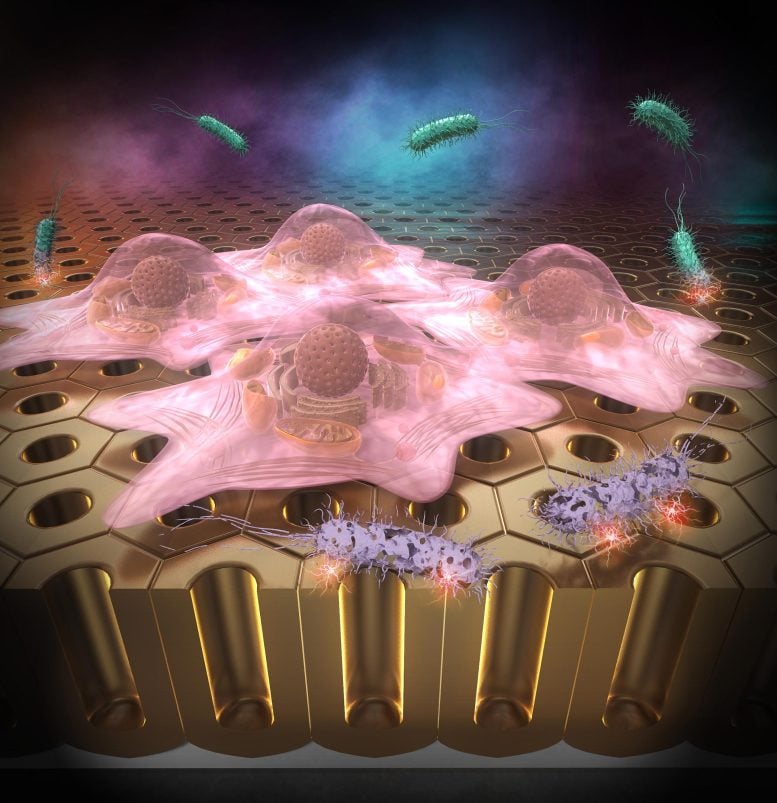 精选
精选
革命性的表面技术杀死细菌并促进细胞生长
诸平
The team have shown that their nanostructured surfaces resist the growth of bacteria, but enable the culturing of cells. Credit: Tokyo Metropolitan University
据日本东京都立大学(Tokyo Metropolitan University)2025年1月11日提供的消息,革命性的表面技术杀死细菌并促进细胞生长(Revolutionary Surface Technology Kills Bacteria and Powers Cell Growth)。
新的纳米结构氧化铝表面(alumina surfaces)提供前所未有的抗菌性,及培养更安全的没有抗生素的再生医学(regenerative medicine)细胞培养环境。相关研究结果于2024年12月7日已经在《朗格缪尔》(Langmuir)杂志发表——Takaaki Murata, Kumiko Yamaguchi, Takashi Yanagishita(柳下崇). Evaluation of the Antibacterial and Cell Culture Properties of Anodic Porous Alumina Prepared in Concentrated H2SO4. Langmuir, 2024, 40(50): 26706-26713. DOI: 10.1021/acs.langmuir.4c03873. Published 7 December 2024.
参与此项研究的除了来自东京都立大学(Department of Applied Chemistry, Tokyo Metropolitan University, Minamiosawa, Hachioji, Tokyo, Japan)的研究人员之外,还有来自日本三菱化学株式会社(Mitsubishi Chemical Corporation, 1-1 Marunouchi 1-chome, Chiyoda-ku, Tokyo, Japan)的研究人员。
东京都立大学的研究人员已经开发出先进的纳米结构氧化铝表面,这种表面在杀死细菌方面非常有效,同时还能支持培养细胞的生长。通过在浓硫酸中使用电化学过程,该团队创造了具有优异抗菌性能的阳极多孔氧化铝(anodic porous alumina简称APA)表面。这些表面在不干扰细胞培养的情况下阻止细菌生长,为再生医学提供了突破性的解决方案。这项技术可以生产出没有细菌污染的高质量细胞培养物,而无需依赖抗生素。
抗菌表面对公共卫生和日常应用都至关重要。虽然传统方法涉及使用抗生素(antibiotics)和刺激性化学品(harsh chemicals),但这些方法可能危害环境,构成健康风险,并导致耐抗生素细菌的增加。对对抗细菌病原体的替代方法的需求从未如此强烈,而像APA这样的纳米结构表面可能提供更安全、更可持续的解决方案。
这就是纳米结构表面的用武之地。21世纪10年代初,研究表明,蝉(cicada)和蜻蜓(dragonfly)翅膀上自然形成的纳米结构可以抵抗细菌污染。这些结构破坏细菌细胞的细胞膜,阻止它们扩散。因此,科学家们一直在寻找廉价制造可能达到同样效果的人造表面的方法。
抗菌和细胞友好表面的突破(Breakthrough in Antibacterial and Cell-Friendly Surfaces)
由东京都立大学的柳下崇(Takashi Yanagishita)教授领导的研究小组一直在探索阳极多孔氧化铝(APA)的使用。当抛光的铝表面在一定条件下浸入电化学电池时,表面被排列有序的氧化铝(alumina / aluminum oxide))多孔柱覆盖。这些针状柱子的大小正好可以杀死细菌,使其表面具有很强的抗菌性。
现在,该团队已经完善了他们的配方,发现在浓硫酸中制备的APA表面具有明显优于现有表面的抗菌性能。至关重要的是,他们发现这些表面对培养在其上的生物细胞没有危害。在正常细胞培养中,可以在培养基中添加抗生素以防止细菌污染物的发生。这种方法的主要缺点是对耐抗生素细菌无效;事实上,它们的过度使用可能会再次导致更具抗性的菌株的出现。这与APA表面的情况不同,细胞培养可以在没有抗生素添加剂的情况下安全进行。
革命性的医学应用(Revolutionary Applications in Medicine)
研究小组的发现对再生医学来说是一个好消息。再生医学是指在实验室培养细胞,然后用于治疗组织和器官损伤。任何侵入细胞的细菌都可能给病人带来可怕的后果:这通常需要专门的、昂贵的无菌环境。研究小组认为,他们的新底物可能使无抗生素细胞培养在更广泛的环境中实现,可能彻底改变患者治疗的规模,以及我们如何进行科学实验。
这项工作得到了日本学术振兴会(JSPS KAKENHI Grant Number JP24K01219)的部分支持。上述介绍,仅供参考。欲了解更多信息,敬请注意浏览原文或者相关报道。
The antibacterial activity of anodic porous alumina (APA) prepared using phosphoric, oxalic, and sulfuric acids was tested, and it was found that APA prepared using sulfuric acid had the highest antibacterial activity against Staphylococcus aureus and Escherichia coli. In addition, the results of the antibacterial test using APA prepared with different concentrations of sulfuric acid showed that APA prepared in concentrated sulfuric acid exhibited significantly higher antibacterial activity. APA formed in concentrated sulfuric acid also showed excellent antibacterial activity even at a high culture medium concentration, at which bacterial cells tend to multiply easily. Trace amounts of Al and S that leached out to the culture medium from APA prepared in concentrated sulfuric acid did not affect the antibacterial activity of APA, indicating that the APA surface exhibits excellent antibacterial activity. It was shown that the surface of APA prepared in concentrated sulfuric acid had excellent culture properties for fibroblasts while exhibiting antibacterial activity. APA prepared in concentrated sulfuric acid can be used in various applications that require excellent antibacterial activity as well as on surfaces that suppress bacterial growth and selectively cultivate target cells.
转载本文请联系原作者获取授权,同时请注明本文来自诸平科学网博客。
链接地址:https://wap.sciencenet.cn/blog-212210-1468517.html?mobile=1
收藏


